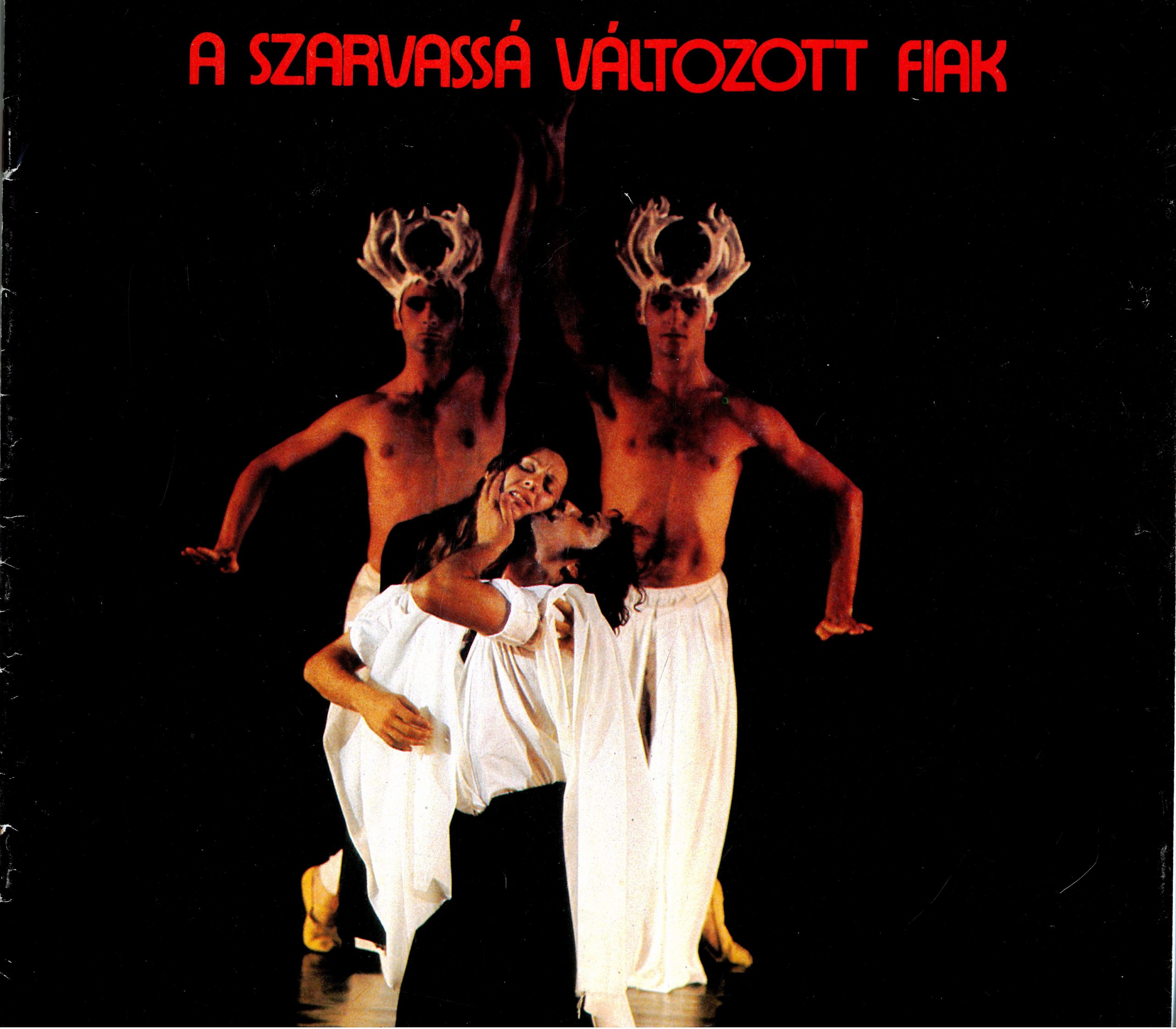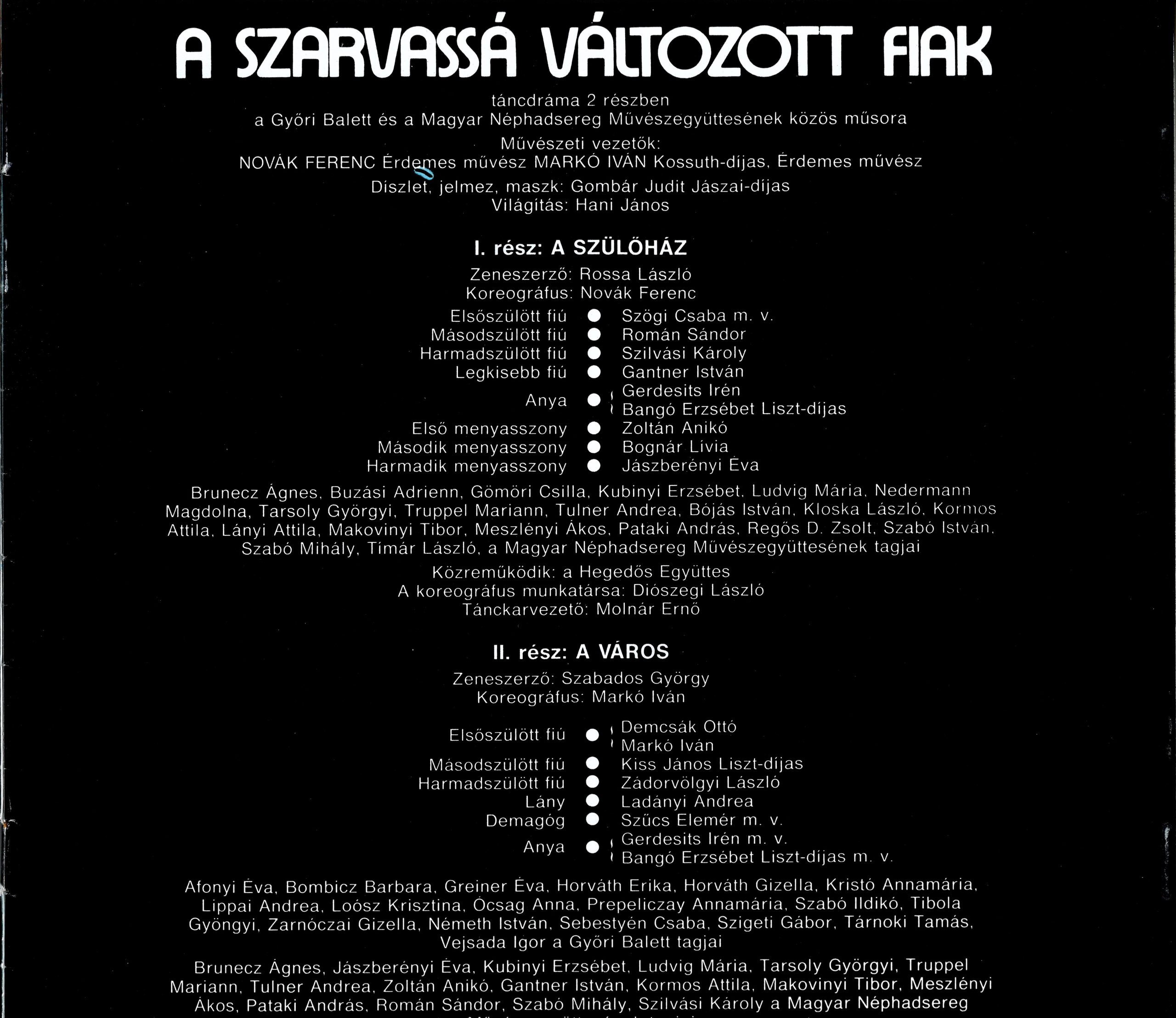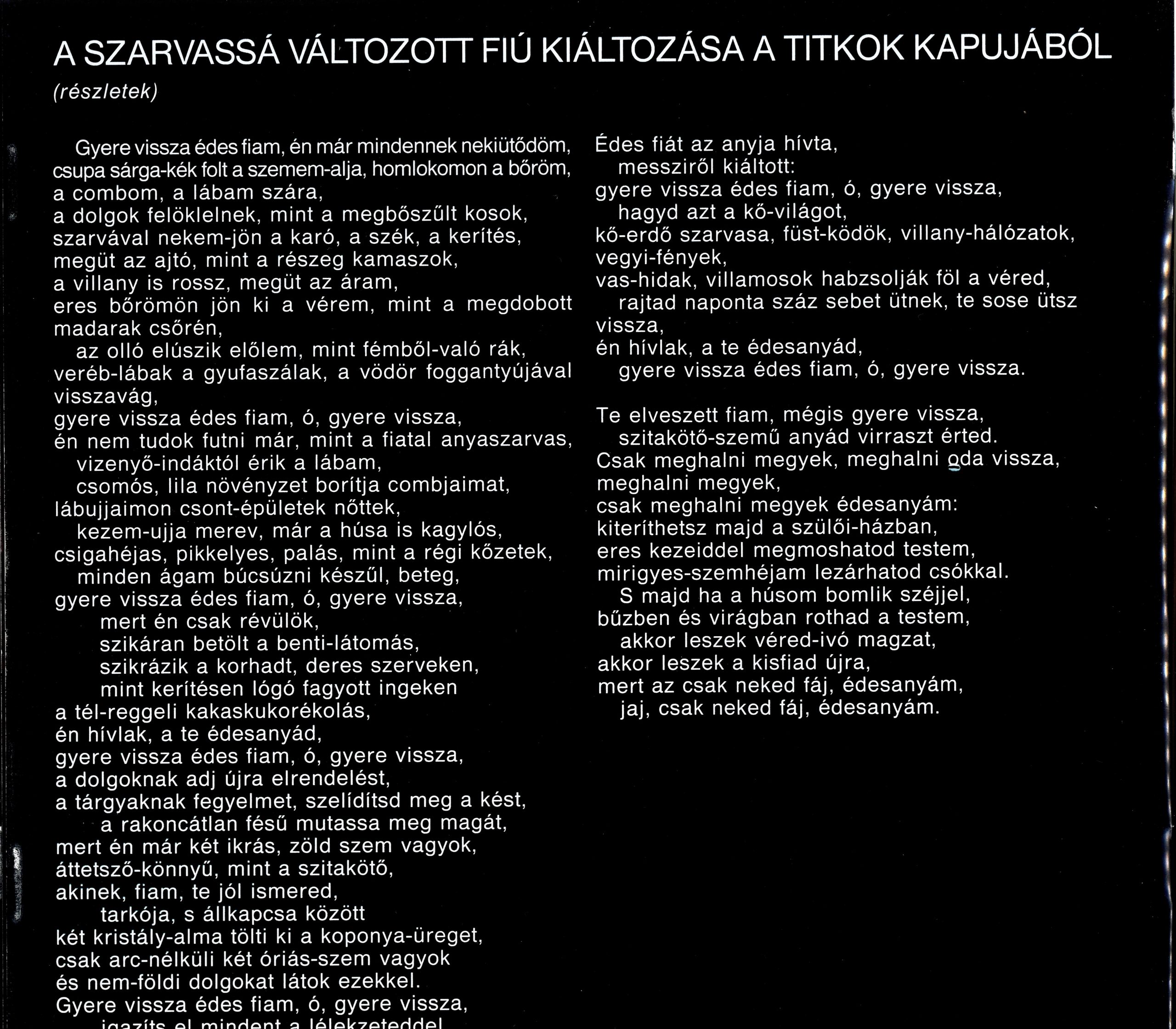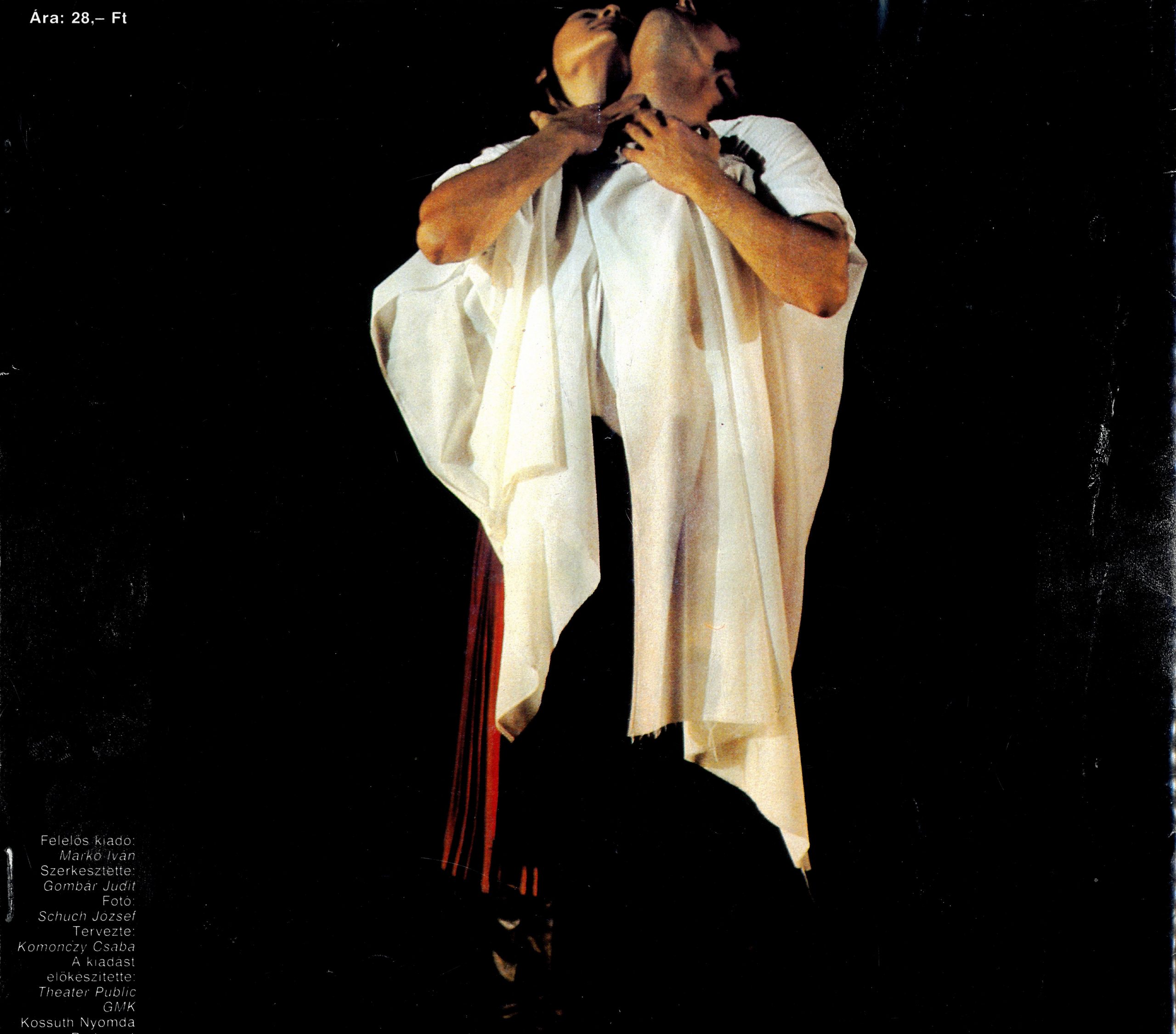The music of The Sons Turned Into Stags was commissioned by ballet director Iván Markó, choreographer, in the fall of 1984, for his troupe Györi Balett (Ballet of Györ). The single act music piece was completed by the end of January 1985 and was recorded in studio 22 of the Hungarian Broadcasting Company in March, with Johannes Bauer, Mihály Dresch Dudas, Antal Lakatos and György Szabados as soloists and the extended MAKUZ Orchestra conducted by the composer.
The basis of the composition, which requires great improvisational practice, is the legend of a Transylvanien KOLINDA (Christmas mountain folk song) of the same title well-known in Eastern Europe in several local variations. Béla Bartók was the first to draw from the story of the sons who lived and died for renewal and purification in his nature hymn. Poet Ferenc Juhasz made it into a poem threateningly full of doubts in witch modern age with its progress, industrial civilization and its ideology, the unwary mind’s paradise on earth became the torturing scene of human revival, from which this piece of music started on its way.
Here the story is irrevocably dramatic, both individually and communally. The sons having stepped out once in the surrounding world with pure heart are now facing challenged by the demons of helplessness and desperations. Withered peace and suicidal “holy” war, deadly modernness and lost past, self-preserving hatred, coward violence and panicky cult of pleasure are opposed in them: parts that won over the Whole. It is the symbiosis of stupid sorcerer’s apprentices and jealous satanlets, all greedy and incapable. Outside, a declining, wild bereft of the spint world, in which the great answer of the irrationality of Nature is prepared behind the fake lavishness of the scenes, inconspicuously and mysteriously….
But deep in this painful myth the life and death of cultures is also at stake in the triple fate of the sons. Choises and ways. Deadly devouring of selfish and unlimited licence (eldest son), the illusion of power and the successive apocalypse (second son), and the fate of the youngest son, who heeds to his heart’s calling but after his borther’s fall he is longing for his mother’s goodness desperately and in vain – there is no way lack for him either. Problems are always the same, timeless and unavoidable.
Man has to save himself first. Suffering again the miracle of existence, submerging in its deep inner lakes, he will have to take the Whole World in his heart and artistic soul. He will have to find himself to unite with the Whole, to form a union with the Gods.
The musical texture of the piece is extremely loose and open, the rhythm is relative, yet the style is strict and the aspiration is to be unambiguously understood. The performance requires the creative cooperation of musicians of the new school.
The ballet has first staged on August 18, 1985 at the Szeged Open Air Festival. The music was performed at a concert of the Budapest Spring Festival, In Petöfi Hall, on March 21, 1988.
György Szabados
A Szarvassá vált fiak zenéjét Markó Iván bаlettigazgató koreográfus rendelte meg 1984 őszén társulata, a Győri Balett számára.
Az egy felvonás terjedelmű zene 1985 január végére készült el, és márciusban került hangfelvételre a Magyar Rádió 22-es stúdiójábаn, amelyben Dresch Dudás Mihály, Johannes Bauer, Lakatos Antal és Szabados György szólistaként, valamint a kibővített budapesti MAKUZ-Zenekar működtek közre, a szerző vezényletével.
A nagy improvizatív gyakorlatot igénylő kompozíció alapjául egy Kelet-Európában ismert, azonos című erdélyi, un. kolinda (karácsonyi, havasi népének) mítosza szolgál, amely már eredeti környezetében is több variációban él. Elsőként Bartók Béla használta fel, öntötte természet-himnuszos műzenébe a megújulásért és megtisztulásért élő-haló fiúk történetét, majd Juhász Ferenc, a költő faragott belőle poémát, de már vészjóslóan kétségekkel telít, amelyben a modern kor: az ipari civilizáció és ideológiája, a korszerűség és a haladás, az óvatlan elme földi paradicsoma lett az emberi újjászületés gyötrelmes terepe, – ahonnan ez a zene járja ösvényeit. A történet itt már végképpen drámai egyéni és közösségi mivoltában egyaránt. A fiak, akik egykor még tiszta szívvel léptek az őket körülvevő világba, az elveszés és a tanácstalanság démonaival találják szemben magukat. Tikkadt béke és öngyilkos „szent” háború, halálos modernség és távolba vеsző múlt, önféltő gyűlölködés, gyáva erőszak, pánikos gyönyör állanak bennük már egymással szemben: valójában a részek, amelyek leteperték az Egészt.
S a buta bűvészinasok és féltékeny sátánykák tehetetlen is telhetetlen szimbiózisa. Egy megromlott, elvadult, szellemtelen világ odakünn, ahol a színfalak hamis pompázata mögött a Természet, az Egész irracionalitásának nagy válasza készül, észrevétlenül és rejtélyesen.
De ennek a gyötrelmes mítosznak a mélyén a kultúrák élete és halála is a tét a fiak hármas képletében. A választások és az utak. Az önző, parttalan szabadság halálos mindent-falása (első fiú), a hatalom idillje és a soros apokalipszis (a második), s a szívére hallgató harmadiké, aki bátyjai szűkségszerű bukása után hiába epekedik vissza kétségbeesetten anyja jóságához, övéi múltja-melegébe, – nincs visszaút. A gondok mindigre mind ugyanazok, lerázhatatlanok, időtlenek. Hiszen az embernek elébb önmagát kell megváltania. Újra megszenvedve a lét nehéz csodáját, s megmerítkezve mély, belső tavaiban, az Egész Világot kell szívébe és művészi idegzetébe fognia: a nagy improvizáció, a szeretet kozmikus lázán át megtalálni helyét és önmagát, hogy egységre lépjen Mindennel, – egyességre az istenekkel.
A darab zenei szövete rendkívül laza, stílusa mégis feszes, textúrája bár fölöttébb nyitott és a ritmikája is viszonylagos, álma – lényege szerint – mégis az, hogy egyértelmű legyen. Előadása is új iskolázottsági muzsikusok alkotó együttműködését feltételezte.
A balett 1985. augusztus 18-án került bemutatásra a Szegedi Szabadtéri Játékokon. A zene hangversenyszerűen 1988. március 21-én a Petőfi Csarnokban hangzott el, a Budapesti Tavaszi Fesztivál keretében.
Szabados György
Die in Hirsche verwandelten Söhne
Die Musik zum Werk Die in Hirsche verwandelten Söhne hat der Ballettdirektor und Choreograph Iván Markó für seine Truppe Győri Ballett (Ballett von Győr) im Herbst 1984 bestellt. Die Musik bestehend aus einem Akt war Ende Januar 1985 fertig und wurde im März im Studio 22 des Ungarischen Radios aufgenommen. Als Dirigent (und Solist) leitete der Komponist die Solisten Mihály Dresch Dudás, Johannes Bauer, Antal Lakatos sowie das erweiterte MAKUZ Orchester von Budapest.
Als Grundlage für die Komposition, welche eine große improvisative Praxis verlangt, diente das Mythos einer in Osteuropa bekannten sog. Kolinda (Weihnachtslied in den Siebenbürgischen Hochgebirgen) mit dem gleichen Titel. Die Kolinda lebt in ihrer ursprünglichen Umgebung bereits in verschiedenen Variationen. Als erster bearbeitete Béla Bartók* die Geschichte der für Erneuerung und Läuterung lebenden und sterbenden Söhne und goss das Thema in Form von Naturhymne-Musik. Der Dichter Ferenc Juhász verarbeitete das Lied in ein Gedicht, aber hat es mit gefahrdrohenden Zweifeln geladen, wo das moderne Zeitalter: die Industriezivilisation und ihre Ideologie, die Modernität und Fortschritt, das irdische Paradies des unachtsamen Geistes zum schmerzhaften Boden der menschlichen Neugeburt wurden – und diese Musik beginnt hier ihren Weg zu gehen. Hier ist die Geschichte endgültig dramatisch in ihrer individuellen und gemeinschaftlichen Beziehung. Die Söhne, die einst mit reinem Herzen die sie umgebende Welt betreten haben, begegnen plötzlich den Dämonen der Verlassenheit und der Ratlosigkeit. In ihnen stehen bereits verdorrter Frieden und selbstmörderischer „heiliger” Krieg, tödliche Modernität und in der Ferne verschwindende Vergangenheit, um sich selber besorgter Hass, feige Gewalt, panikerfüllte Wonne einander gegenüber: Teile, die das Ganze überwältigt haben.
Und die auch machtlos gefräßige Symbiose von dummen Zaubererlehrlingen und eifersüchtigen Täufelchen. Draußen eine verdorbene, verwilderte, geistlose Welt, wo hinter dem Talmi Pomp der Kulissen unbemerkt und geheimnisvoll die große Antwort der Natur, der Irrationalität des Ganzen vorbereitet wird.
Aber in der Tiefe dieses schmerzhaften Mythos, steht das Leben und der Tod der Kulturen auf dem Spiel innerhalb des dreifachen Schicksals der Söhne. Die Wahlmöglichkeiten und die Wege. Das tödlich alles auffressendes Wesen der egoistischen, uferlosen Freiheit (erster Sohn), die Idylle der Macht und die darauffolgende Apokalypse (zweiter Sohn) und der dritte Sohn, der seinem Herzen zuhört und der sich nach dem notwendigen Fall seiner Brüder verzweifelt aber umsonst zur Güte seiner Mutter zurücksehnt, in die Vergangenheit und Wärme der Seinen – es gibt jedoch keinen Rückweg. Die Probleme sind immer dieselben, unvermeidbar, zeitlos. Da der Mensch zuerst sich selber erlösen muss. Er muss das schwere Wunder der Existenz wieder erleiden, und in ihren tiefen, inneren Seen untertauchend muss er die Ganze Welt in sein Herz und schöpferische Seele ziehen: durch die große Improvisation, das kosmische Fieber der Liebe muss er seinen Platz und sich selber finden, damit er mit dem All eine Einheit – mit den Göttern ein Bündnis macht.
Die musikalische Struktur des Stückes ist sehr locker, sein Stil jedoch straff. Obwohl die Struktur offen und die Rhythmik relativ sind, sein Traum ist – nach seiner Essenz – dass es unmissverständlich wirkt. Die Vorführung hat die schöpferische Zusammenarbeit von neu geschulten Musikern vorausgesetzt. Das Ballett wurde am 18. August 1985 während den Freilichtspielen in Szeged uraufgeführt. Die Musik wurde als Konzert am 21. März 1988 in der Petőfi Csarnok im Rahmen des Frühlingsfestivals Budapest gespielt.
György Szabados
Übersetzung von Tharan Marianne (Januar 2016)
* Cantata profana
Musicians
composition
for the composition: A szarvassá vált fiak (The Sons Turned into Stags):
Official Releases
LP / CD
Recording
Compositions
Musicians
Release Date: 1989
Recording Date: März 1985.
Recorded at: Studio 22, of the Hungarian Broadcasting Company, Budapest
LP Site A) The Sons Turned into Stags – A szarvassá vált fiak 22:28
LP Site B) The Sons Turned into Stags – A szarvassá vált fiak 24:10
György Szabados and the MAKUZ-Orchester
Dirigent: Szabados György
Musicians:
Szabados György (piano, preap. piano) (solo)
Lőrincz János (fl)
Szemő Tibor (fl. bass-fl.) (solo)
Dresch Dudás Mihály (fl., ss, ts) (solo)
Grencsó István (alt fl., bcl, as)
Lakatos Antal (ts) (solo)
Kovács Ferenc (tp) (solo)
Mákó Miklós (tp)
Johannes Bauer (tb) (solo)
Zakar Zoltán (tb)
Binder Károly (p)
Faragó Antal (perc.) (solo)
Baló István (perc.) (solo)
Geröly Tamás (perc)
Lantos Zoltán (vl)
Tréfás István (vl)
Hlács Gusztáv (vl)
Virág László (vl)
Körmendy Ferenc (viola)
Jacobi László (violoncello)
Benkő Róbert (double bass)
Lőrinszky Attila (double bass)
Kiss Gábor (double bass)
Release Date: 1999
Recording Date: März 1985.
Recorded at: Studio 22, of the Hungarian Broadcasting Company, Budapest
György Szabados and the MAKUZ-Orchester
Dirigent: György Szabados
Musicians:
Szabados György (piano, preap. piano) (solo)
Lőrincz János (fl)
Szemő Tibor (fl. bass-fl.) (solo)
Dresch Dudás Mihály (fl., ss, ts) (solo)
Grencsó István (alt fl., bcl, as)
Lakatos Antal (ts) (solo)
Kovács Ferenc (tp) (solo)
Mákó Miklós (tp)
Johannes Bauer (tb) (solo)
Zakar Zoltán (tb)
Binder Károly (p)
Faragó Antal (perc.) (solo)
Baló István (perc.) (solo)
Geröly Tamás (perc)
Lantos Zoltán (vl)
Tréfás István (vl)
Hlács Gusztáv (vl)
Virág László (vl)
Körmendy Ferenc (viola)
Jacobi László (violoncello)
Benkő Róbert (double bass)
Lőrinszky Attila (double bass)
Kiss Gábor (double bass)
Release Date: 2007
Recording Date: März 1985.
Recorded at: Studio 22, of the Hungarian Broadcasting Company, Budapest
A szarvassá vált fiak (The Sons Turned into Stags) (4. tétel) 10:45
György Szabados and the MAKUZ-Orchester
Dirigent: György Szabados
Musicians:
György Szabados (piano, preap. piano) (solo)
Lőrincz János (fl)
Szemő Tibor (fl. bass-fl.) (solo)
Mihály Dresch Dudás (fl., ss, ts) (solo)
István Grencsó (alt fl., bcl, as)
Lakatos Antal (ts) (solo)
Ferenc Kovács (tp) (solo)
Miklós Mákó (tp)
Johannes Bauer (tb) (solo)
Zoltán Zakar (tb)
Károly Binder (p)
Antal Faragó (perc.) (solo)
István Baló (perc.) (solo)
Tamás Geröly (perc)
Zoltán Lantos (vl)
István Tréfás (vl)
Gusztáv Hlács (vl)
László Virág (vl)
Ferenc Körmendy (viola)
László Jacobi (violoncello)
Róbert Benkő (double bass)
Attila Lőrinszky (double bass)
Gábor Kiss (double bass)
known music performances
Performance Date
Location
Musicians
Recording
1988, 21 Mar.
Music presentation at Budapest Spring Festival in the Petofi Hall, Budapest (HU)
Szabados György (piano)
Binder Károly (piano)
Lakotos Antal (sax)
Johannes Bauer (trombone)
other Musicians unknown
known Ballet / Fine art theater performances
Performance Date
Location
Ballet
Recording
1985, 26 April
Ballet präsentation Mechanikus kert (Mechanic garden), at the National Theatre of Györ in Hungary to Szabados composition Tánczene from the Adyton LP.
Győri Balett (dance performance)
György Szabados (Composer)
Iván Markó (Dance director, Choreographer)
Judit Gombár (Decorator)
1985, 17 Aug.
1985, 18 Aug.
Ballet premiere präsentation A szarvassá vált fiak (The Sons Turned into Stags), Choreography at Dóm tér, the Szeged Open Air Festival in Szeged (HU) – there where 2 performances per day
Győr Ballet, directed by Markó Iván
1985, 7 Nov.
Ballet präsentation A szarvassá vált fiak (The Sons Turned into Stags), Choreography at Győri Kisfaludy Színház, in Győr (HU)
Győr Ballet, directed by Markó Iván
1985, 21 Dec.
1985, 22 Dec.
Ballet präsentation Mechanikus kert (Mechanic garden) in the Smetena Theatre in Prague (ex Czecheslowakia, now CZ), with music of Szabados composition Tánczene from the Adyton LP.
Győri Balett (dance performance)
György Szabados (Composer)
Iván Markó (Dance director, Choreographer)
Judit Gombár (Decorator)
1986, 22 April
1986, 23 April
Ballet präsentation Mechanikus kert (Mechanic garden) in the Csokonai-Theater in Debrecen (HU) with music of the Szabados composition Tánczene from the Adyton LP.
Győri Balett (dance performance)
György Szabados (Composer)
Iván Markó (Dance director, Choreographer)
Judit Gombár (Decorator)
1986, 25 June
Ballet präsentation Mechanikus kert (Mechanic garden) in Baltimore (US) with music of the Szabados composition Tánczene from the Adyton LP.
Győri Balett (dance performance)
György Szabados (Composer)
Iván Markó (Dance director, Choreographer)
Judit Gombár (Decorator)
1986, 9 Aug.
1986, 10 Aug.
Ballet präsentation A szarvassá vált fiak (The Sons Turned into Stags), Choreography at Dóm tér, the Szeged Open Air Festival in Szeged (HU)
Győr Ballet, directed by Markó Iván
2011, 4 Aug.
2011, 5 Aug.
2011, 6 Aug.
2011, 7 Aug.
Stage performance where the actors have no texts (fine art theatre) with the title: “sziklarajz.hu (Rock drawings)”, at Zsámbéki színházi bázis, Etyeki u. 2, Zsámbék (HU)
Performance by Zsámbéki Színházi Bázis & Kompánia Színházi (Kompania Theater Company), directed by László Lukács
![]() “To become a stag” – Interview with director László Lukács – Nóra Váradi [In: harag.eu, 2011, 8 August]
“To become a stag” – Interview with director László Lukács – Nóra Váradi [In: harag.eu, 2011, 8 August]
![]() [In: Pesti Műsor, 2011, 1 Aug., page 25]
[In: Pesti Műsor, 2011, 1 Aug., page 25]







